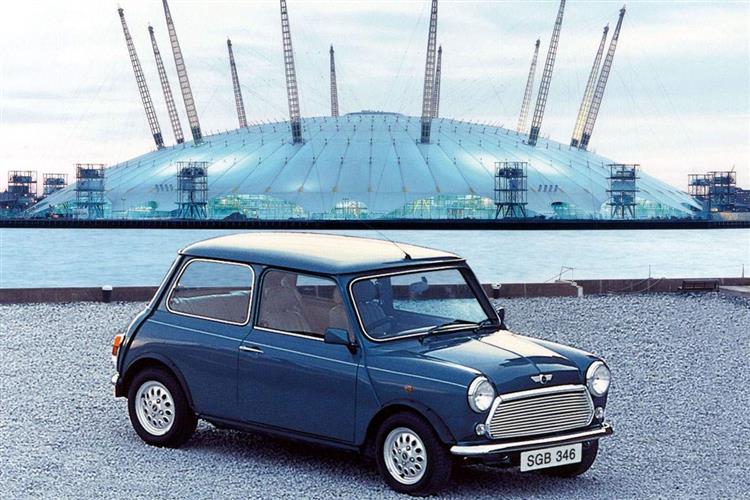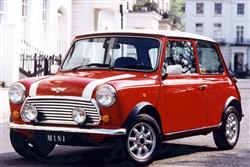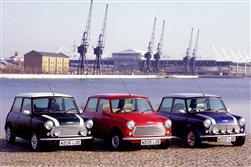MINI HAPPY RETURNS (some text hidden) --NONE--
BY JONATHAN CROUCH
Introductionword count: 97
This is the car that started the small car revolution. If you've never driven a Mini, then you're in the minority. Most of us squeezed ourselves behind the wheel at one time or another in our formative years and if we're honest, most of us enjoyed the experience. There was something about driving a Mini, a cheeky quality which today's breed of 'superminis' have found impossible to duplicate. It was an individual car created by an individualist: Alexander Arnold Constantine Issigonis. In the 2000s, it's something of a cult car. And of course, there are plenty about.
Modelsword count: 21
Models Covered: 2 door Mini 1000 - 1984-1992 [City E, City, Mayfair]Mini 1.3 - 1992-to date [Sprite, Mayfair, i, Cooper, Cabriolet])
Historyword count: 1031
Against all expectations, the Mini remained in production until July 2000, well over 40 years after its launch. In fact, the story of the car goes back a little further than that - to 1956 and the petrol rationing which came in the wake of the Suez crisis. Initially, the market had responded to this new demand for economy with a string of so-called 'bubble' cars, mainly imported from Germany. The British Motor Corporation, created four years earlier by the merger of Austin and Morris, wanted to create a new small contender to drive the bubble cars off the road. It had to be a proper car with four seats. It had to use an existing BMC engine. And it had to be smaller than the two current compact cars then being built by BMC, the Austin A35 and the Morris Minor. Otherwise, the new car's designer was to be given a free hand. Issigonis turned his mind to the smallest possible car that would still accommodate four adults and luggage. His idea was for a box measuring approximately 10' x 4' x 4' of which 80% should be given over to passengers and luggage, leaving only two feet in length to accommodate the powertrain. He realised from the outset that to fit everything into the space available, he would need to use very small 10" wheels and all-independent suspension. But the real genius was his idea of using a transverse engine to drive the front wheels via a gearbox built into the sump. It was a revolutionary concept and one which the British market took a little time to adjust to. The first year's production (the eight months from May to December 1959) amounted to less than 20,000 cars. Things picked up the next year however, with 100,000 Minis made, a figure which doubled in 1962 and stayed above that level until 1977. The early cars were full of little idiosyncrasies - some practical, some not. There was a separate starter button, for example, mounted on the floor (which made sense since the battery was mounted in the boot). There was no dashboard in the ordinary sense, just a full-width parcel shelf, with a speedometer incorporating a fuel gauge in a central nacelle. Performance enthusiasts became interested in the car in 1961 with the announcement of the twin-carburettor Mini Cooper, followed two years later by the even more potent Mini-Cooper 'S'. This was the car that put British rallying firmly on the world stage, thanks to Paddy Hopkirk and Henry Liddon's victory in the 1964 Monte Carlo Rally. The Cooper didn't last however, as a production car; neither did the Estate version which sold quite well in the Seventies (and created the Minivan). By 1980, the Estate and the staple long-nose Clubman two-door version had disappeared to leave just two variants; the basic City and the plush Mayfair. Both of these were powered by a 40bhp 1.0-litre engine (offered with a catalyst from 1989). In September 1990, the Cooper version returned, with a new 1275cc 61bhp engine. In 1991, this unit was replaced by a 63bhp 1.3-litre engine and the same powertrain was placed in the new entry-level Sprite (which replaced the City) in 1992; the Mayfair got the 1275cc engine at this time. By November 1992, all Minis came with catalysts and had 1.3-litre power; in July 1993, a pricey Cabriolet version was put on sale. Very little then happened until 1996, when the whole range was given a refresher. Outward visual clues to the revised car were few - unless you were a Mini fanatic. These included clear directional indicators at the front. Inside, there was a driver's side airbag (what would Issigonis have made of that?) housed in a chunky three-spoke steering wheel borrowed from the MGF sportscar. Pointing out front behind it were "up to the moment" column stalks. There was even an intermittent setting for the wipers and a two-speed fan - heady stuff. The seats too came in for the 1990s treatment. They were based on those used in the Rover 200, with 'break back' squabs, which could be released to fold forward, easing access to the rear. Other detail changes include a new leather-clad gear knob and a chromed gear lever. Chrome bezels around instrument dials set in a new wood fascia meanwhile, were supposed to evoke memories of the classic sixties. Other improvements included seatbelt pre-tensioners, side door anti-intrusion beams, an immobiliser and an alarm. The more important changes however, took place under the skin. The radiator for example, was at last moved from the side to the front of the engine bay. The 1275cc Cooper engine, now standardised across the range, got Rover's most powerful engine management computer to give fully programmed sequential fuel injection. There was also a direct (distributor less) electronic ignition system. Unfortunately, all this did not lead to an improvement in the 63bhp power output. In fact, due to "an inevitable" weight increase of about 3.5%, there was actually a slight reduction in "on paper" performance, with the top speed now at 90mph and rest to sixty taking 12.2s. Just two models were now being offered, the Mini 1.3i and the Mini Cooper 1.3i. They were identical apart from the Cooper's distinguishing white roof, bonnet stripes, spot lamps and sports alloy wheels. For another £795, you could buy a `Sports Pack`, including Minilite-style alloy wheels, four front-mounted rally style fog lams, chrome tailpipes and extra instrument gauges. However, buyers who went this route, had to be prepared for the maximum speed to drop to 84mph. The final 'Classic' range was announced in April 2000. Just 4,000 were produced in three versions, all with the same 63bhp 1.3-litre engine. The Seven was badged as a tribute to the first Mini (the Austin Seven) and had an interior supposed to be reminiscent of the 1959 model. Next up was the Cooper, with a smarter black leather-trimmed interior. At the top was the Cooper Sport with interior trimmed in black and nickel leather with 'race-style' alloy fittings and a metallic-finish fascia. There was also a polished alloy gearknob and a leather-trimmed steering wheel. The Mini finally died late in 2000.
What You Getword count: 44
Arguably, an affordable classic - the Japanese love them. Minis are noisy (though later ones were better soundproofed), crude, cramped and huge fun to drive. They're still cheap to run and easy to DIY with (except the exhaust which is terribly difficult to replace).
To see the full road test text contact us on 0330 0020 227
Pictures (high res disabled)


|

|
Scoring (subset of scores)
Category: Small Runabouts
| Performance | |
| Handling | |
| Comfort | |
| Space | |
| Styling, Build, Value, Equipment, Depreciation, Handling, Insurance and Total scores are available with our full data feed. | |



